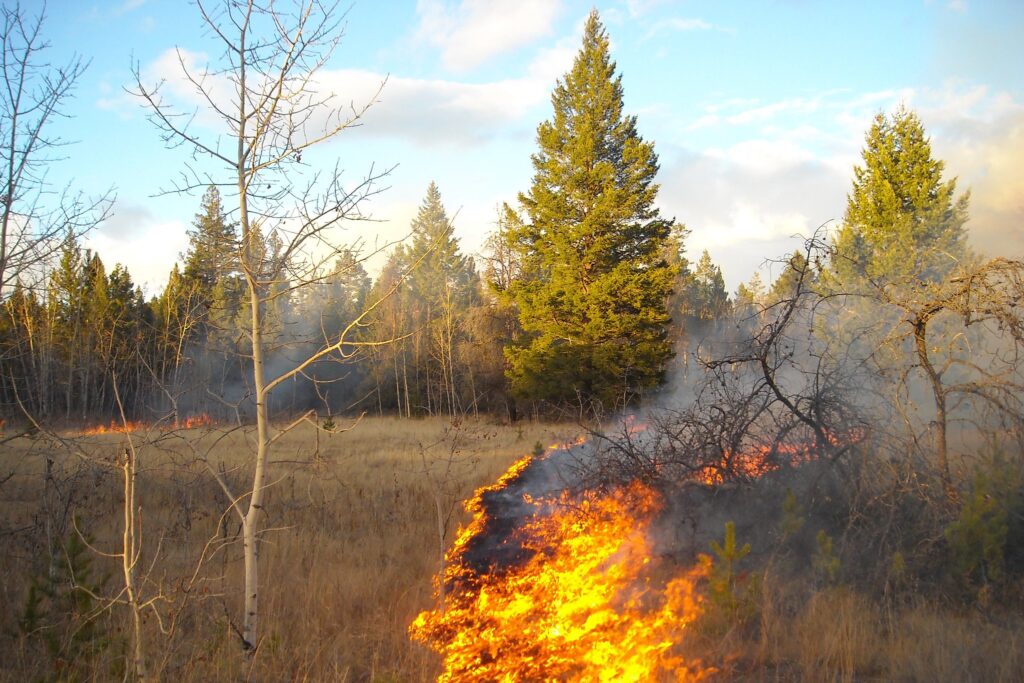Interested in hearing more about how local governments can take action to create more holistic practices in managing the natural environment? Check out our new Healthy Natural Environments Action Guide. It contains information on the health benefits of natural environments, guidance on incorporating equity in natural environment planning, information on pertinent legislation, and examples of action from B.C. communities.
The Esk’etemc have taken community and environmental health back into their own hands. The “people of the white earth” have created an environment supporting healing and closure, resurrecting traditional governance structures, providing community with opportunities to build social cohesion and heal from past and persistent wrongdoings, as well as encourage individual wellness and self-determination. Esk’etemc-owned-and-operated natural resource companies support the economy, creating a sustainable workforce committed to stewarding the natural environment. Investing in inclusivity, autonomy and community capacity, the Esk’etemc are building a healthier, sustainable community for themselves and generations to come.
Introduction
Wildfires across British Columbia bring a heightened sense of fear in communities. For Esk’etemc, a looming fear of wildfires in the Cariboo Regional District has been replaced with a renewed confidence in community ability to manage wildfire risk and a certainty that its decision-making is transparent and reflective of the community. Located 50km southwest of Williams Lake in the Cariboo Region, Esk’et (Alkali Lake) is home to nearly 400 of the more than 1,000 Esk’etemc members.
The Esk’etemc and their natural environment are resilient. Older generations have lived through dark times, systemic racism, and community struggles with alcohol. Efforts to combat these colonially-induced problems, including a sobriety movement in the 1970’s and 80’s and inter-generational investments in individual and community health, have led to a reclaiming of their role as caretakers of Esk’etemculucw—“the land of the Esk’etemc—allowing the people to retake authority, manage natural resources and steward the land.
Building Blocks
A share of Esk’etemc’s resurgence in environment and resource management lays in their reassertion of Indigenous knowledge and land management practices. The First Nation has blended the inclusionary form of traditional governance, Yucwemintem, with the Indian Act-mandated system of Chief and Council, reopening channels for community healing, local knowledge sharing and participatory decision-making.
Part of the revitalization is attributable to the Esk’etemc-owned forestry and resource management enterprises, Alkali Resource Management Ltd. (“ARM”) and Ecolink Forest Services Ltd. (“Ecolink”). Leading Esk’etemc’s resource and wildfire management projects, they are indispensable for building local capacity and economic opportunities.
Governance
The natural environment surrounding Esk’et has long been cared for and, in return, it has supported the Esk’etemc. In May 2017, the Esk’etemc voted to step away from treaty negotiations and assert Aboriginal title and rights. The declaration arose from their relationship to the land and their belief in better protecting and safeguarding the forests, water, air, medicine and way of life.
The Esk’etemc merged Chief and Council, with Yucwemintem, a matriarchal governance structure that uses the knowledge of the Kyéyes (grandmothers) and women to give direction to Esk’etemc’s Hereditary Chiefs. Chiefs then delegate tasks to their headmen, who look after the community’s families.
Although decisions come from Elders and Chiefs, monthly meetings invite representatives from each family and all community members to express their needs and opinions. Many families have turned to younger generations to represent them, bringing a youthful balance in a space traditionally filled by older family members. In turn, many active Yucwemintem members are employed by ARM. This allows for a natural cross-pollination of traditional knowledge sharing and wildfire mitigation input from families and community members who otherwise would not be heard.
As Francis Johnson, Hereditary Chief and elected Councillor, explains, Yucwemintem provides opportunity for widespread community input, with the band council still responsible for policy making and programming. Community interaction with elected officials has not always been so well-mannered. The Indian Act governance structure is inherently bureaucratic, and the community may have a distrust of non-Indigenous governments.
Chief and Council have found the Yucwemintem group instrumental for community communication and bridging this distrust, reminding community members that elected officials are also concerned community members. As established by a community vote, large decisions are being made through Yucwemintem and elected governance working together, with Chief and Council giving their approval and support for projects and grant applications through Band Council Resolutions.
Esk’etemc-owned Companies Drive Land Stewardship

Established in 1990, Ecolink was the community’s response to concern over a lack of communication with the forestry sector and influence in timber harvesting near traditional lands. This led to a nearly three-decade long, mutually beneficial venture between the community and what is now Tolko Industries Ltd. Ecolink expanded beyond its initial scope: what started as a tree spacing operation has grown to include the growing and cultivation of trees and a community-led logging company.
In 2000, as community exposure to the forestry industry grew, Esk’etemc began applying for and receiving tenures to manage the forest on and around reserve lands. ARM now manages the tenures on behalf of the community. Today it employs anywhere from 20 to 75 Esk’etemc community members on various forestry and silviculture projects. ARM works closely with Ecolink, hiring a primarily Esk’etemc workforce.
During a March 2006 bid process, Esk’etemc was recognized for its expertise in community-led forest and resource management and was awarded a Community Forest Agreement by the Ministry of Forests, Lands, Natural Resource Operations and Rural Development. Encompassing over 27,000 hectares, the Esk’etemc Community Forest was one of the province’s first community forests to transition from a pilot agreement to a community forest with a long-term tenure.
In B.C., forestry and forest tenures are dominated by large private corporations. Community forests are unique— they are managed by local governments, community groups and community-held corporations. While conventional logging agreements and private industry consider the bottom line first, community forests take a three-pillar approach that reflects economic, social and ecological sustainability.
ARM’s other forestry agreements and legislative requirements (First Nations Woodland tenure, Non-replaceable Forest Licenses and Woodlot License) require high-level management plans and conforming to government objectives. The First Nation fulfills these mandates and goes beyond government standards. For example, non-timber plant species that grow in tenured forests are important to the community for traditional medicine and food sources. The Esk’etemc highlight these in their management plans, although no current regulation or standard specifies how to manage these non-timber species. This historical lack of consideration has damaged traditional species and led to what could be viewed as the exploitation of Esk’etemc resources. Mushroom picking by settlers on recently burned Esk’etemc territory is one persistent challenge. Other examples of exploitation include grazing permits for cattle, guide and trapping outfits, and right-of-ways for infrastructure projects that have led to forest and plant clearing and a lack of access.
Strategic Wildfire Prevention Initiative
In 2010, the Esk’etemc undertook a Community Wildfire Protection Plan (CWPP). Shortly after, ARM joined community wildfire efforts after being awarded a BC Wildfire Service contract to provide two five-person firefighting crews. Exhibiting the growth of investments in community members, ARM now has four five-person fire crews and in 2018 the company was awarded a contract for two more-advanced, four-person wildfire suppression crews.
Following the devastating 2017 wildfire season, the First Nation began creating a Wildfire Risk Management Plan (WRMP). It brought together a host of community members to identify the greatest wildfire risks. It takes an ecosystem-based management approach that addresses the landscape holistically. Recognizing all things on the land are connected through the Creator, the plan is larger in scope and more logical—it extends beyond the regional boundaries drawn on maps, which do not stop wildfire.
The community agreed that areas with built-up fuel needed to be managed first and posed the greatest threat to homes and community infrastructure. Esk’et also has very few routes in and out. The WRMP identified roads that in 2017 wildfires became bottle-necks, constraining evacuation and increasing danger.
In Fall 2018, the Esk’etemc were able to leverage this knowledge, applying for and receiving $720,000 dollars from the Forest Enhancement Society to address certain wildfire concerns and create evacuation plans. The community built on this momentum, receiving funding from the Strategic Wildfire Prevention Initiative through the Union of British Columbia Municipalities to continue removing fuel and debris.
In the Esk’etemc’s traditional territory, deadfall decays far slower than in coastal and mountainous regions. With this knowledge, the Esk’etemc historically used fire—controlled burning—to look after their land and manage wildfire risk. During the early 1990’s, however, technologies and bureaucracies discouraged this custom and replaced it with new-age expertise. For a host of reasons, including the inability to proactively burn wildfire fuel, fires in the coming decades became more of a danger to the region. For the Esk’etemc, the 2017 wildfire evacuations served as a tipping point to take action, reincorporating fire on their land and reapplying this traditional forest management value and ecological knowledge.[1]
For their part, the BC government recognizes Esk’etemc’s knowledge and practices, leading to ARM working with the Cariboo Fire Centre to guide underbrush and broadcast burns, as well as larger, controlled burns, which remove wildfire fuel. Each year, experience and capacity grow as ARM and the Esk’etemc community work with BC Wildfire Service (BCWS) to review prescribed burns. The partnership has led to field tours with BCWS staff, demonstrating the value of local expertise and Indigenous knowledge in Esk’etemc’s wildfire projects.
The community thinks critically about maintaining their WRMP, as well as infrastructure such as fire breaks. The plan will evolve over time; as demonstrated by the appointment of the fire headman and expanding fire crews, many solutions rely on community capacity building, decision-making and cultivating further connection with traditional land management practices.
Receiving Feedback
Community Elders have provided feedback throughout these wildfire processes. Elders largely identified the importance of using fire and traditional burning practices to ensure a resilient, proactive, and independent community. To Elders, it is critical the community feel safe staying in their homes and on their land, even with fires burning around them. This is no small feat: there are currently about 20 community members active on wildfire prevention projects, including local high school students who receive mentorship from experienced Esk’etemc fire and forestry workers. This results in summer employment for youth and builds intergenerational capacity to address wildfires by putting them in direct contact with the natural environment.
At ARM, receiving community feedback has become easier due to its strong tie to Yucwemintem. Those involved understand the community’s support of the processes and gratefulness for the work being done. As Community Forest Manager Gord Chipman expressed, the community always speaks up to course-correct when things are not going according to plan.
Conclusion
The resurgence of the Esk’etemc community began with a reinvestment in the health of its people. By blending inclusionary forms of traditional governance with the decision-making of Chief and Council, the Esk’etemc are reasserting traditional knowledge and land management practices. The First Nation has long used fire as a tool in natural environment—through community-owned and -operated businesses ARM and Ecolink, the Esk’etemc are proving tremendously successful in managing the natural environment and putting fire back on the land.
“Whether it’s using fire, Western science or traditional knowledge, it’s all linked to being on the land and making decisions.” — Francis Johnson, Esk’etemc Hereditary Chief and elected councillor
Here are some questions to consider for local governments looking to engage in this type of work:
-
What channels could you use to improve public participation and get better input from all of your community’s groups?
-
What are some existing tensions in your work/community that, if given the chance to be addressed publicly, could remove barriers to progressing your work/community’s health?
-
What are some opportunities your community has to create community-owned or not-for-profit organizations?
-
What are some existing funding opportunities that could help your community take on natural environment improvement projects?
-
What local knowledge does your community hold that could support and leverage provincial and federal initiatives?
-
What are some ways you can be proactive about encouraging environmental stewardship in your community?
[1] Johnson, Francis T7exwemnesq’t. (2019).Incorporating traditional values in forest management. Community of Esk’et & Alkali Resource Management.




